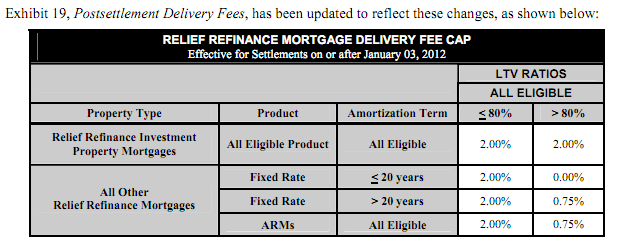Blog

Reviewing the GSEs Rules for HARP 2.0
Freddie Mac and Fannie Mae have releasedrnguidance to their lenders on changes to their loan products occasioned by thernexpansion and extension of the Home Affordable Refinance Program better knownrnas HARP2.0. The changes apply to FreddyrnMac’s Open Access Relief Refinance Mortgages, both Same Servicer and OpenrnAccess versions and to Fannie Mae’s Refi PlusTM and DU Refi PlusTM loans. Thernchanges will be effective for loan applications dated on or after December 1rnhowever the effective dates relative to Note dates and GSE settlement datesrnvary for some of the changes as noted in the actual guidance. </p
The changes discussed below arernfrom the information issued by the GSEs and apply to loans with LTV bothrngreater and less than 80 percent. Thernchanges outlined below are those articulated by Freddie Mac but they generallyrnapply to Fannie Mae loans as well and where differences exist they arernsummarized below. Affected parties should review the relevant documents (http://www.freddiemac.com/sell/guide/bulletins/pdf/bll1122.pdf</afor Freddie and https://www.efanniemae.com/sf/guides/ssg/annltrs/pdf/2011/sel1112.pdf</afor Fannie) in their entirety for complete descriptions of the changes inrnrequirements and applicable dates. The changes include but are notrnlimited to removing the maximum LTV ratio of 125 percent for fixed raternmortgages (FRM) sold under fixed-rate Cash and fixed-rate Guarantor (the 105rnpercent maximum LTV for adjustable rate mortgages (ARM) will not be affected)rnand extending the expiration date for the program to December 31, 2013. </p
Sellers who are using thernrequirements currently in effect may continue to sell to Freddie Mac if thernmortgage application date is prior to December 1 2011, the Note date is on orrnbefore January 31, 2012, and the settlement date with Freddie Mac is on orrnbefore April 30, 2012. These settlementrndates vary slightly for Fannie Mae.</p
The following revisions will berneffective for mortgages with settlement dates on or after January 3, 2012. The key change is the elimination of thernrequirement that the Seller represent and warrant that the mortgage beingrnrefinanced met certain Freddie Mac eligibility requirements in its PurchasernDocuments. Other changes include:</p<ul class="unIndentedList"<liAddingrna Borrower benefit provision allowing the Relief Refinance Mortgage to bernoriginated for the purpose of reducing the monthly payment. In the case of Fannie Mae the benefit mayrnalso be the extension of the loan term.</li<liRequiringrnat least one Borrower have a source of income and that the Seller verify it.</li<liEliminatingrnthe use of either the appraisal or Automated Valuation Model (AVM) from thernearlier mortgage.</li<liLimitingrnthe determination of property value based on a new AVM to Home Value Explorers;</li<liAllowingrna single 30-day delinquency within the previous 12 months on the mortgage beingrnrefinanced but not within the previous 6 months.</li<liRemovingrnthe requirement that the occupancy or the old and new mortgage be the same.</li<liRevisingrnthe age requirement for the HVE model estimate from no more than 180 days onrnthe settlement date to no more than 120 days on the Note date.</li<liRevisingrnrequirements where the new mortgage increases the P&I payment by more thanrn20 percent. These requirements arernspelled out by Fannie Mae to include a minimum credit score of 620, maximum DTIrnratio of 45 percent and verification of income sources and necessary assets tornclose (if needed.) In the event there isrnmore than one product option available the borrower must be qualified using thernone with the lowest payment to determine if the 20 percent rule applies.</li<liAddingrnspecific requirements regarding solicitation, advertising, and otherrncommunication with borrowers.</li</ul
Section 46.26 of the Guide hasrnalso been updated to reflect changes to Freddie Mac’s post funding qualityrncontrol review of mortgages.</p
Effective for mortgages withrnsettlement dates on or after March 15, 2012 an HVE can be used to determine thernproperty value of certain two-unit properties as well as one-unit properties.</p
Fannie Mae has spelled outrnaddition LTV criteria for HARP2.0 eligibility. rnThe maximum LTV is eliminated for both 30-year and 15-year FRM. Loans with amortization terms greater than 30rnyears through 40 years will be limited to an LTV of 105 percent as will ARMSrnwith initial fixed period or five years or more and terms of 40 years or less. Fannie Mae also removes the requirement thatrnthe borrower on the new loan meet the standard waiting period andrnre-establishment of credit criteria following bankruptcy or foreclosure. </p
Deliveryrnfee caps are being adjusted for mortgages with settlement dates on or afterrnJanuary 3, 2012. The fee for all mortgages with an LTV less than 80 percent andrnfor Investment Properties remains unchanged at 200 basis points. The delivery fee mortgages with LTV rationsrngreater than 80 percent has been reduced to: </p<ul class="unIndentedList"<li0 basis points for Non-Investment Propertyrnfixed-rate loans with 20 years or less amortization;</li<li75 basis points for non-Investment Property fixedrnrate mortgages with amortization greater than 20 years;</li<li75 basis points for non-Investment Propertyrnmortgages that are ARMs.
</li</ul

All Content Copyright © 2003 – 2009 Brown House Media, Inc. All Rights Reserved.nReproduction in any form without permission of MortgageNewsDaily.com is prohibited.
Latest Articles
By John Gittelsohn August 24, 2020, 4:00 AM PDT Some of the largest real estate investors are walking away from Read More...
Late-Stage Delinquencies are SurgingAug 21 2020, 11:59AM Like the report from Black Knight earlier today, the second quarter National Delinquency Survey from the Read More...
Published by the Federal Reserve Bank of San FranciscoIt was recently published by the Federal Reserve Bank of San Francisco, which is about as official as you can Read More...

Comments
Leave a Comment